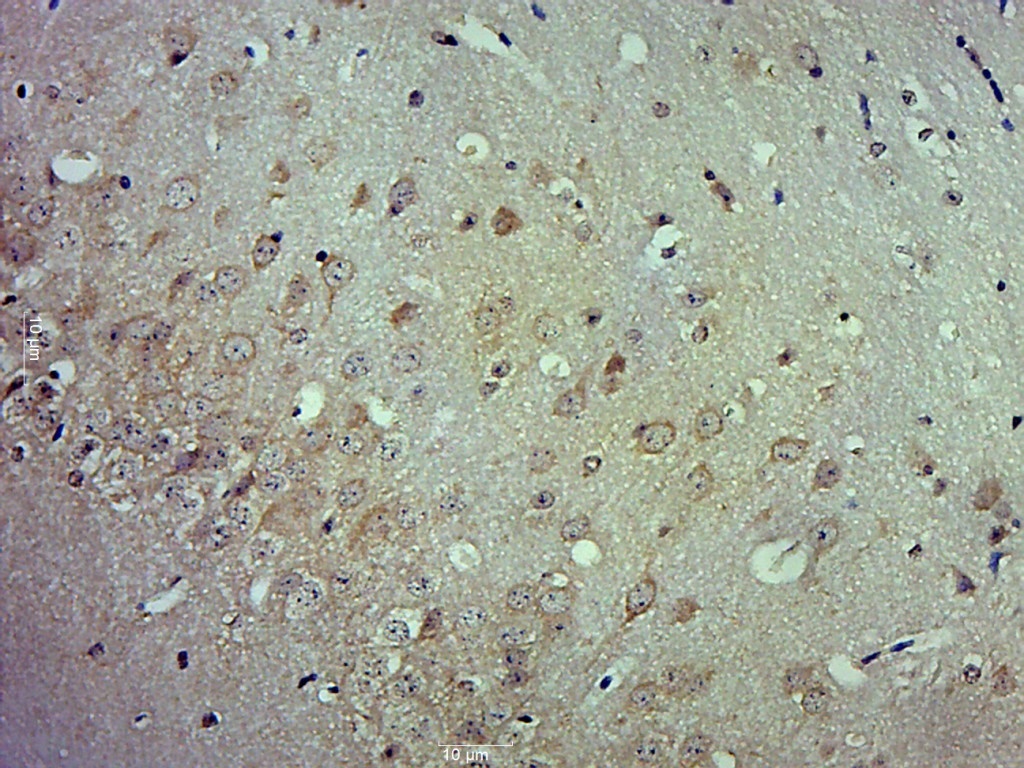
Rabbit Anti-sLOX 1 antibody
Soluble Lectin-like oxidized low density lipoprotein receptor-1; sLOX-1; soluble form, C-type lectin domain family 8 member A; CLEC8A; hLOX 1; hLOX-1; Lectin like oxidized LDL receptor 1; Lectin like oxLDL receptor 1; Lectin type oxidized LDL receptor 1;
View History [Clear]
Details
Product Name sLOX 1 Chinese Name 可溶性凝集素样氧化低密度Lipoprotein受体1抗体 Alias Soluble Lectin-like oxidized low density lipoprotein receptor-1; sLOX-1; soluble form, C-type lectin domain family 8 member A; CLEC8A; hLOX 1; hLOX-1; Lectin like oxidized LDL receptor 1; Lectin like oxLDL receptor 1; Lectin type oxidized LDL receptor 1; Lectin-like oxidized LDL receptor 1; Lectin-like oxLDL receptor 1; Lectin-type oxidized LDL receptor 1; LOX-1; Olr1; OLR1_HUMAN; Ox LDL receptor 1; Ox-LDL receptor 1; Oxidised low density lipoprotein (lectin like) receptor 1; Oxidized low density lipoprotein receptor 1; Oxidized low density lipoprotein receptor 1 soluble form ; Oxidized low-density lipoprotein receptor 1; SCARE1; Scavenger receptor class E, member 1. Research Area Cardiovascular immunology Synthesis and Degradation Immunogen Species Rabbit Clonality Polyclonal React Species Human, Mouse, (predicted: Rat, ) Applications ELISA=1:5000-10000 IHC-P=1:100-500 IHC-F=1:100-500 IF=1:100-500 (Paraffin sections need antigen repair)
not yet tested in other applications.
optimal dilutions/concentrations should be determined by the end user.Theoretical molecular weight 31kDa Cellular localization The cell membrane Secretory protein Form Liquid Concentration 1mg/ml immunogen KLH conjugated synthetic peptide derived from human sLOX 1: 201-273/273 <Extracellular> Lsotype IgG Purification affinity purified by Protein A Buffer Solution 0.01M TBS(pH7.4) with 1% BSA, 0.03% Proclin300 and 50% Glycerol. Storage Shipped at 4℃. Store at -20 °C for one year. Avoid repeated freeze/thaw cycles. Attention This product as supplied is intended for research use only, not for use in human, therapeutic or diagnostic applications. PubMed PubMed Product Detail Receptor that mediates the recognition, internalization and degradation of oxidatively modified low density lipoprotein (oxLDL) by vascular endothelial cells. OxLDL is a marker of atherosclerosis that induces vascular endothelial cell activation and dysfunction, resulting in pro-inflammatory responses, pro-oxidative conditions and apoptosis. Its association with oxLDL induces the activation of NF-kappa-B through an increased production of intracellular reactive oxygen and a variety of pro-atherogenic cellular responses including a reduction of nitric oxide (NO) release, monocyte adhesion and apoptosis. In addition to binding oxLDL, it acts as a receptor for the HSP70 protein involved in antigen cross-presentation to naive T-cells in dendritic cells, thereby participating in cell-mediated antigen cross-presentation. Also involved in inflammatory process, by acting as a leukocyte-adhesion molecule at the vascular interface in endotoxin-induced inflammation. Also acts as a receptor for advanced glycation end (AGE) products, activated platelets, monocytes, apoptotic cells and both Gram-negative and Gram-positive bacteria.
Function:
Receptor that mediates the recognition, internalization and degradation of oxidatively modified low density lipoprotein (oxLDL) by vascular endothelial cells. OxLDL is a marker of atherosclerosis that induces vascular endothelial cell activation and dysfunction, resulting in pro-inflammatory responses, pro-oxidative conditions and apoptosis. Its association with oxLDL induces the activation of NF-kappa-B through an increased production of intracellular reactive oxygen and a variety of pro-atherogenic cellular responses including a reduction of nitric oxide (NO) release, monocyte adhesion and apoptosis. In addition to binding oxLDL, it acts as a receptor for the HSP70 protein involved in antigen cross-presentation to naive T-cells in dendritic cells, thereby participating in cell-mediated antigen cross-presentation. Also involved in inflammatory process, by acting as a leukocyte-adhesion molecule at the vascular interface in endotoxin-induced inflammation. Also acts as a receptor for advanced glycation end (AGE) products, activated platelets, monocytes, apoptotic cells and both Gram-negative and Gram-positive bacteria.
Subcellular Location:
Cell membrane; Single-pass type II membrane protein. Secreted. Note=A secreted form also exists.
Tissue Specificity:
Expressed at high level in endothelial cells and vascular-rich organs such as placenta, lung, liver and brain, aortic intima, bone marrow, spinal cord and substantia nigra. Also expressed at the surface of dendritic cells. Widely expressed at intermediate and low level.
Post-translational modifications:
The intrachain disulfide-bonds prevent N-glycosylation at some sites.
N-glycosylated.
DISEASE:
Note=Independent association genetic studies have implicated OLR1 gene variants in myocardial infarction susceptibility.
Similarity:
Contains 1 C-type lectin domain.
SWISS:
P78380
Gene ID:
4973
Database links:Entrez Gene: 4973 Human
Entrez Gene: 108078 Mouse
Omim: 602601 Human
SwissProt: P78380 Human
SwissProt: Q9EQ09 Mouse
Unigene: 412484 Human
Unigene: 293626 Mouse
Unigene: 87449 Rat
Product Picture
References (0)
No References
Bought notes(bought amounts latest0)
No one bought this product
User Comment(Total0User Comment Num)
- No comment



 +86 571 56623320
+86 571 56623320
 +86 18668110335
+86 18668110335

